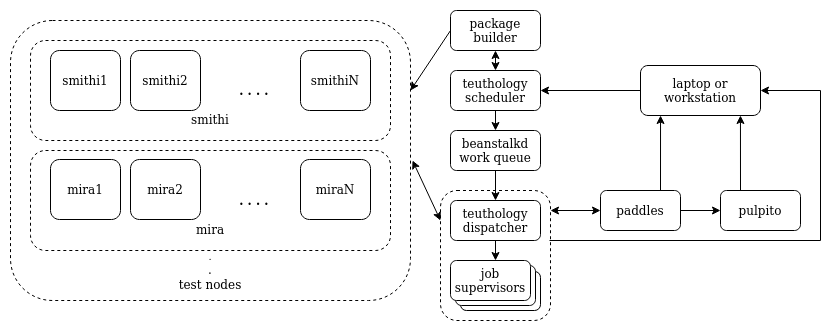Ceph Lab Components¶
The distinct hardware/software components that a lab is composed of and the way they interact between them is described here. In general, a lab is composed of a scheduler, worker(s), package builder (gitbuilder), job database (paddles), job archive, a web UI (pulpito) and test nodes.

In the figure above, every service appears on a separate machine but this is
not a requirement (see Teuthology Lab Setup Notes for an alternative setup). Jobs are
submitted to the scheduler, which are then picked up by dispatcher and
processesed by job supervisors. One supervisor processes and keeps track of a
job (one at a time). The output of the job (logs and files associated to an
execution) is stored in the archive, which is a path in the file system where
the dispatcher is running. The job database contains information about the status
of jobs and test nodes, as well as results of executions (# of tests passed,
failed, etc.). All this information can be visualized in pulpito, the web
UI. For an example, see Ceph community’s Lab here.
Test nodes can be grouped in classes (referred to as machine-type),
allowing teuthology schedule jobs across multiple hardware setups.
Life of a Teuthology Job¶
The teuthology scheduler exposes a work queue (using beanstalkd) where jobs are submitted. The life of a
job begins when teuthology-suite is executed, which is when a job is
prepared and queued (teuthology-schedule is implicitly invoked). When a job
is created (or whenever the status of a job is changed, e.g. from queued to
started), information about the job is recorded in paddles’s internal
database. Depending on the priority of the job, the scheduler eventually
determines when a job can get executed. At this point,
teuthology-dispatcher checks the lock status of the requested
machines by querying paddles, acquires locks of the
nodes if they are available, and invokes teuthology-dispatcher in
supervisor mode. supervisor reimages the target machines and invokes
teuthology (the command). teuthology proceeds to execute the job
(execute every task in the YAML job description). After the execution is
completed (ie teuthology process exits), supervisor unlocks or nukes
the target machines depending on the status of the job. If the requested
machines are not available, the dispatcher waits for the machines to be
available before running anymore jobs. Results from the job are stored in the
archive directory of the worker for forensic analysis.
Since QA suites usually
specify install and ceph tasks, we briefly describe what they do. When
a suite is scheduled (via teuthology-suite), the branch that is being
worked against has to be specified (e.g. a git SHA or ref). Packages
for the given branch and distro are probed on gitbuilder to see if they exist.
Once this and other sanity checks pass, the job is created and scheduled. Once
the job initializes, the install task pulls and installs Ceph packages from
gitbuilder. The installation task might also be preceded by a kernel
task which first reboots testnodes (and optionally installs) into a specified
kernel. The ceph task subsequently configures and launches the cluster. At
this point, Ceph is ready to receive requests from other tasks (such as
rados).